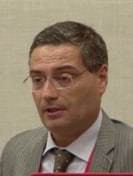Biography
Luca Pierantoni was born in Maiolati Spontini, Italy. He received (1988) the Laurea Degree (summa cum laude) in Electronic Engineering and the PhD Degree (1993) in Electromagnetics from the University of Ancona, Italy. From 1996 to 1999, he worked at the Technical University of Munich, Germany, as Senior Research Scientist.
He is currently Full Professor of Electromagnetic Fields at the Università Politecnica delle Marche (UnivPM), Ancona, Italy.
His research interests are in the i) investigation of the combined Maxwell-quantum transport phenomena in nano-materials/-devices; ii) development of a computational techniques for the multi-physics modeling of nano-to-meso-scale devices/systems, including electrodynamics, quantum mechanics, thermal effects, spintronics and for applications that cover the areas of microwave, photonics, opto-mechanics, plasmonics, metamaterials, quantum computing; iii) atomistic (ab initio) simulations aimed at deriving electronic properties and constitutive relations of novel and smart materials (e.g. ferroelectrics, phase change materials).
Awards and membership. Co-founder and first chair of the MTT-S “RF Nanotechnology” technical committee. IEEE MTT-S Distinguished Microwave Lecturer (DML, 2012-2014) and IEEE MTT-S DML Emeritus (DML-E, 2015-2016). IEEE Nanotechnology Council (NTC) Distinguished Lecturer (2015-2016). Member of the Nanotechnology Council (NTC) AdCom (since 2012). Member of the International Microwave Symposium Technical Program Committee. Senior Editor of the IEEE Trans. on Nanotechnology (TNANO). Associate Editor of the Journal of Comp. Electronics (JCE, Springer), Nanomaterials & Nanotechnology (NMNT, INTECH). EuMA Member. Member of the Italian Institute of Nuclear Physics (INFN). Vice-Chair, Quantum Technologies Working Group, Technical Coordination & Future Directions Committee. He is an IEEE Senior Member.
Granted projects. UnivPM PI in the Europen Projects “Wideband optical antennae for use in energy harvesting applications (GreEnergy)”, H2020-LC-SC3-2020-RES-RIA; “Nanomaterials enabling smart energy harvesting for next-generation Internet-of-Things (NANO EH)”, H2020 FET PROACTIVE (2020-2022); “Artificial permittivity and permeability engineering for future generation sub wavelength analogue integrated circuits and systems (NANOPOLY)”, H2020 FETOPEN (2019-2021); “Nano components for electronic smart wireless circuits and systems (NANOSMART)”, H2020 ICT (2019-2021); “Nanoarchitectronics (NTX)”, H2020 FETOPEN (2017-2018); “All-Phononic circuits Enabled by Opto-mechanics (PHENOMEN)”, H2020 FETOPEN (2016-2019); “Carbon based smart system for wireless applications (NANO RF)”, FP7 ICT (2012-2016); “Multi-layered sandwich graphene devices (MILESAGE)”, GRAPHENE FLAGSHIP (2014-2016). PI of the Project “Wireless devices based on carbon nanotubes traveling wave (TW-CNT)”, Québec-Italie Project (2011-2012).
Publications. He is author or coauthor of about 250 papers in peer-reviewed journals and conferences.
Presentations
Multiphysics Modeling of the Electromagnetic-Transport Problems in Nanodevices: A New Challenge in Computational Engineering
The presentation deals with the multiphysics analysis and modeling of the combined electromagnetic-coherent transport problem in new-concept electronics based on nano-structured material and devices. We introduce full-wave techniques both in the frequency (energy)-domain and the time-domain for the investigation of new devices based on carbon materials, namely carbon nanotube (CNT), graphene, graphene nanoribbon (GNR). The quantum transport is described by the Schrödinger equation or its Dirac-like counterpart, for small energies. The electromagnetic field provides sources terms for the quantum transport equations, that, in turns, provide charges and currents for the electromagnetic field. In the frequency-domain, a rigorous Poisson-coherent transport equation system is provided, including electrostatic sources (bias potentials). Interesting results involve new concept-devices, such as multipath/multilayer GNR circuits, where charges are ballistically scattered among different ports under external electrostatic control. Further examples are given by the simulation of cold-cathodes for field emission based on graphene and by the analysis of optical emission/absorption by single or few layer GNR. In the time-domain, we introduce a full-wave approach, in which the Maxwell equations, discretized by the transmission line matrix (TLM) method are self-consistently coupled to the Schrödinger/Dirac equations, discretized by a proper finite-difference time-domain scheme. We show several examples of the electromagnetics/transport dynamics in realistic environments. It is highlighted that the self-generated electromagnetic field may affect the dynamics (group velocity, kinetic energy etc.) of the quantum transport. This is particularly important in the analysis of time transients and in the describing the behavior of high energy carrier bands, as well as the onset of non-linear phenomena due to external impinging electromagnetic fields. We are now working on novel applications, in particular THz carbon-based emitters and detectors, exploiting intriguing mechanisms such as frequency multiplication, semiconductor quantum cascade, optical wave mixing, Bloch oscillation, photoconductive effects.
